 |
 |
Our enthusiastic and extremely knowledgeable perennials team is here to answer your questions and help you choose the best perennials for your situation. There’s always something in bloom for sun, shade, butterflies, birds or deer resistance as well as a variety of bulbs for your space.
Stroll through our time-tested favorites and introduce yourself to the newest varieties. We garden with perennials too; we love them and it shows!
|
26 found, showing page 1 of 2
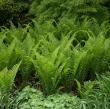
Height: 24 inches
Spacing: 3 feet
Sunlight: full sun, partial shade, full shade
Hardiness Zone: 1b
Description:
The most common and recognizable of the ferns, this is a very tough and hardy plant, featuring tall lacy fronds all season long; spreads aggressively and may require some control; grows best in shade with rich, moist soil; great for textural effect
Ornamental Features:
Ostrich Fern is primarily valued in the garden for its ornamental upright and spreading habit of growth. Its large fragrant ferny compound leaves remain light green in color throughout the season.
Landscape Attributes:
Ostrich Fern is an herbaceous fern with an upright spreading habit of growth. Its relatively fine texture sets it apart from other garden plants with less refined foliage.
This is a high maintenance plant that will require regular care and upkeep, and is best cleaned up in early spring before it resumes active growth for the season. Deer don't particularly care for this plant and will usually leave it alone in favor of tastier treats. Gardeners should be aware of the following characteristic(s) that may warrant special consideration:
- Invasive
Ostrich Fern is recommended for the following landscape applications:
- Mass Planting
- General Garden Use
- Groundcover
- Naturalizing And Woodland Gardens
Planting & Growing:
Ostrich Fern will grow to be about 24 inches tall at maturity, with a spread of 4 feet. When grown in masses or used as a bedding plant, individual plants should be spaced approximately 3 feet apart. It tends to be leggy, with a typical clearance of 1 foot from the ground, and should be underplanted with lower-growing perennials. It grows at a fast rate, and under ideal conditions can be expected to live for approximately 20 years. As an herbaceous perennial, this plant will usually die back to the crown each winter, and will regrow from the base each spring. Be careful not to disturb the crown in late winter when it may not be readily seen!
This plant performs well in both full sun and full shade. It is an amazingly adaptable plant, tolerating both dry conditions and even some standing water. It is not particular as to soil pH, but grows best in rich soils. It is highly tolerant of urban pollution and will even thrive in inner city environments. This species is native to parts of North America. It can be propagated by division.
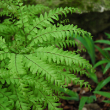
Height: 18 inches
Spread: 24 inches
Sunlight: partial shade, full shade
Hardiness Zone: 1b
Description:
A wonderful low maintenance selection perfect for adding delicate texture to gardens and patio containers; arching fronds of light green turn beautiful golden yellow in the fall; prefers shaded areas with rich and moist well drained soil
Ornamental Features:
Northern Maidenhair Fern is primarily valued in the garden for its cascading habit of growth. Its crinkled ferny compound leaves are light green in color. As an added bonus, the foliage turns a gorgeous gold in the fall. The black stems are very colorful and add to the overall interest of the plant.
Landscape Attributes:
Northern Maidenhair Fern is an herbaceous fern with a shapely form and gracefully arching fronds. It brings an extremely fine and delicate texture to the garden composition and should be used to full effect.
This is a relatively low maintenance plant, and usually looks its best without pruning, although it will tolerate pruning. Deer don't particularly care for this plant and will usually leave it alone in favor of tastier treats. It has no significant negative characteristics.
Northern Maidenhair Fern is recommended for the following landscape applications:
- Mass Planting
- Rock/Alpine Gardens
- General Garden Use
- Groundcover
- Naturalizing And Woodland Gardens
Planting & Growing:
Northern Maidenhair Fern will grow to be about 18 inches tall at maturity, with a spread of 24 inches. Its foliage tends to remain dense right to the ground, not requiring facer plants in front. It grows at a slow rate, and under ideal conditions can be expected to live for approximately 15 years. As an herbaceous perennial, this plant will usually die back to the crown each winter, and will regrow from the base each spring. Be careful not to disturb the crown in late winter when it may not be readily seen!
This plant does best in partial shade to shade. It prefers to grow in moist to wet soil, and will even tolerate some standing water. It is not particular as to soil pH, but grows best in rich soils. It is highly tolerant of urban pollution and will even thrive in inner city environments, and will benefit from being planted in a relatively sheltered location. Consider applying a thick mulch around the root zone over the growing season to conserve soil moisture. This species is native to parts of North America, and parts of it are known to be toxic to humans and animals, so care should be exercised in planting it around children and pets. It can be propagated by division.
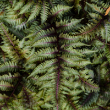
Height: 18 inches
Spread: 24 inches
Sunlight: partial shade, full shade
Hardiness Zone: 3a
Other Names: Crested Japanese Painted Fern
Description:
An excellent choice for adding fine textures to garden beds and borders; features a low growing habit with arching grey green fronds with silver variegations and deep red midribs; easy to grow, requiring little to no maintenance; shade loving variety
Ornamental Features:
Japanese Painted Fern is primarily valued in the garden for its cascading habit of growth. Its attractive ferny bipinnately compound leaves emerge deep purple in spring, turning grayish green in color with showy silver variegation throughout the season. The burgundy stems are very colorful and add to the overall interest of the plant.
Landscape Attributes:
Japanese Painted Fern is a dense herbaceous fern with a shapely form and gracefully arching fronds. It brings an extremely fine and delicate texture to the garden composition and should be used to full effect.
This is a relatively low maintenance plant, and usually looks its best without pruning, although it will tolerate pruning. Deer don't particularly care for this plant and will usually leave it alone in favor of tastier treats. It has no significant negative characteristics.
Japanese Painted Fern is recommended for the following landscape applications:
- Mass Planting
- Border Edging
- General Garden Use
- Groundcover
- Naturalizing And Woodland Gardens
Planting & Growing:
Japanese Painted Fern will grow to be about 18 inches tall at maturity, with a spread of 24 inches. Its foliage tends to remain dense right to the ground, not requiring facer plants in front. It grows at a slow rate, and under ideal conditions can be expected to live for approximately 15 years. As an herbaceous perennial, this plant will usually die back to the crown each winter, and will regrow from the base each spring. Be careful not to disturb the crown in late winter when it may not be readily seen!
This plant does best in partial shade to shade. It prefers to grow in moist to wet soil, and will even tolerate some standing water. It is particular about its soil conditions, with a strong preference for rich, acidic soils. It is somewhat tolerant of urban pollution, and will benefit from being planted in a relatively sheltered location. Consider applying a thick mulch around the root zone over the growing season to conserve soil moisture. This is a selected variety of a species not originally from North America, and parts of it are known to be toxic to humans and animals, so care should be exercised in planting it around children and pets. It can be propagated by division; however, as a cultivated variety, be aware that it may be subject to certain restrictions or prohibitions on propagation.
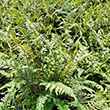
Height: 18 inches
Spread: 24 inches
Sunlight: partial shade, full shade
Hardiness Zone: 3a
Other Names: Crested Japanese Painted Fern
Description:
An excellent choice for adding fine textures to garden beds and borders; features a low growing habit with arching grey green fronds with silver variegations and deep red midribs; easy to grow, requiring little to no maintenance; shade loving variety
Ornamental Features:
Japanese Painted Fern is primarily valued in the garden for its cascading habit of growth. Its attractive ferny bipinnately compound leaves emerge deep purple in spring, turning grayish green in color with showy silver variegation throughout the season. The burgundy stems are very colorful and add to the overall interest of the plant.
Landscape Attributes:
Japanese Painted Fern is a dense herbaceous fern with a shapely form and gracefully arching fronds. It brings an extremely fine and delicate texture to the garden composition and should be used to full effect.
This is a relatively low maintenance plant, and usually looks its best without pruning, although it will tolerate pruning. Deer don't particularly care for this plant and will usually leave it alone in favor of tastier treats. It has no significant negative characteristics.
Japanese Painted Fern is recommended for the following landscape applications:
- Mass Planting
- Border Edging
- General Garden Use
- Groundcover
- Naturalizing And Woodland Gardens
Planting & Growing:
Japanese Painted Fern will grow to be about 18 inches tall at maturity, with a spread of 24 inches. Its foliage tends to remain dense right to the ground, not requiring facer plants in front. It grows at a slow rate, and under ideal conditions can be expected to live for approximately 15 years. As an herbaceous perennial, this plant will usually die back to the crown each winter, and will regrow from the base each spring. Be careful not to disturb the crown in late winter when it may not be readily seen!
This plant does best in partial shade to shade. It prefers to grow in moist to wet soil, and will even tolerate some standing water. It is particular about its soil conditions, with a strong preference for rich, acidic soils. It is somewhat tolerant of urban pollution, and will benefit from being planted in a relatively sheltered location. Consider applying a thick mulch around the root zone over the growing season to conserve soil moisture. This is a selected variety of a species not originally from North America, and parts of it are known to be toxic to humans and animals, so care should be exercised in planting it around children and pets. It can be propagated by division; however, as a cultivated variety, be aware that it may be subject to certain restrictions or prohibitions on propagation.
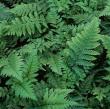
Grayish-green, deeply cut, leathery fronds. Easily grown in average, medium, well-drained soil. USDA 3-8
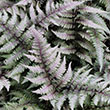
Striking, silvery-green foliage with blue tones. Large, clumping variety. USDA 3-8

A vigorous, deciduous vase-shaped fern with shamrock green arching fronds. USDA 3-8
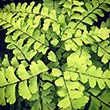
Finely textured frilly fronds. Wiry stems. Native. Clumping. USDA 3-8

Purple blooms. Green corrugated leaves with lemony margins. USDA 3-8
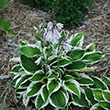
Dark green leaves that are sharply contrasted by bold white edges. Purple blooms. USDA 3-8
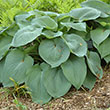
Large blue-green foliage. Lilac and white Blooms. USDA 3-8.
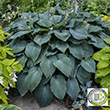
Gigantic, heart-shaped, blue-green leaves are heavy & very slug resistant. Tolerates deep shade and black walnut. USDA 3-8
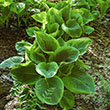
Round, crinkled blue leaves edged in gold. White flowers bloom mid-summer. USDA 3-8
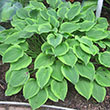
Compact with green heart-shaped leaves with striking golden edges. Masses of purple flowers in mid-summer. USDA 3-8
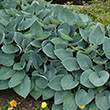
Heart-shaped, metallic blue-gray foliage. Pale lavender flowers. USDA 3-8
26 found, showing page 1 of 2













